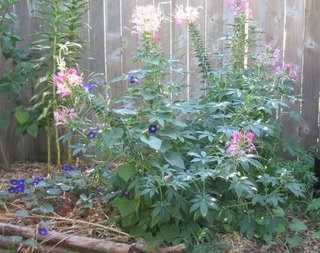
So far not called in. This could change wiwthout a moment's notice.
Getting ready to bike to work tomorrow. Nobody needs to worry about "getting ready to drive to work tomorrow" but that's not true for bike commuting. The following are needed for me (if it's not actively raining - then there's more):
1. A clean change of clothes. If I forget something, I'm out of luck. I keep a pair of shoes at work, so I dont have to carry those too. CLothese are packed in rain-resistant bags, and carried in a side pack. If I happen to drive to work, I take some clothes to leave there, but that is happening less often now.
2. Sometimes, shower supplies like a towel & soap (although I leave them there so I dont need to take them every day).
3. Food. There are no 'healthy' places to eat near where I work. Really, zero, it's all fast food. And no time to go there even if there were. Lately, this entails salad greens, a few tomatoes, some bread, peanut butter, and some yogurt. For tomatoes & salad a non-mashable container is needed. A small rubbermaid box does the job.
4. The key card needs to be accessible so I don't have to stop and un-bungie everything to get into the building.
Keys need to be the last thing packed, so I dont wonder while I'm riding if I forgot them. Can't get into the desk without keys.
5. Any home-work goes into a water- and dirt-proof package.
6. On the off-chance that I'll be paged, the
pager needs to be on my clothing in a location where it won't fall off, and can hopefully be heard. So, the
cell phone also needs to be out of the "bungied" rubbermaid box, and on my person, too. And in a safe location that wont fall off.
7. Now that it's darker in the am, the
diode lights need to be in working order. So, the batteries need to be charged. These render me fully visible on the road (one bike commuter told me that someone thought he was a christmas tree on wheels. The better to be seen by motorists).
8. Bike gear set out. The best sweat band is a folded bandana - machine washable, no elastic to wear out, cheap. Currently, wool socks and hiker sandals; these will be exchanged for something more water-resistant soon. Bike shorts and a T-shirt.
9. Coffee pre-measured and water ready to turn non coffee maker on first rising, to saave a few minutes.
10. Check tires & lights before going to bed.
If it wasnt for the 'earth-friendly' and 'veggie' thing, it would be easier, but that isn't 'me'.
I can't believe that I do all of this. Actually, it doesnt take that long - maybe 15 minutes. It's remembering everything that was difficult, and once in the routine, not a big deal.
Still, it's worth it and the rewards are many -
exercise that leaves me feeling good, doing something that I
feel good about,
observing the neighborhoods that I ride through, and feeling a bit like the
'road warrier' that I like to think I am. Sometimes. Sort of.
Oh - the photo. This is a
brugmansia. These are in the nightshade family (like tomatoes, potatoes, and eggplants). Faintly fragrant. Amazing to look at in person, they look tropical and lush, and vaguely sinister. Apparently they can be overwintered by letting them dry out and leaving them in the basement with a rare addition of water when very dry, same as fig trees, fuscias, and geraniums. We will find out, this winter.

 Is it the cool floor? Or proximity to this humble blogger? Either way, it's nice to have them here. One room away, they have soft beds but they choose the spot shown, at my feet.
Is it the cool floor? Or proximity to this humble blogger? Either way, it's nice to have them here. One room away, they have soft beds but they choose the spot shown, at my feet.









